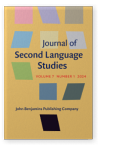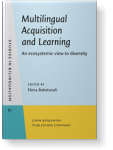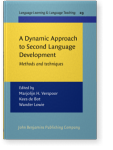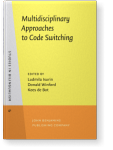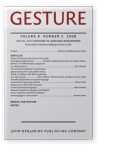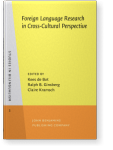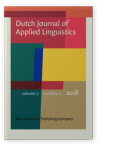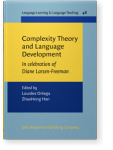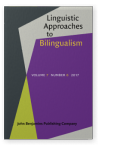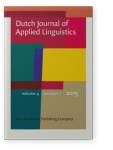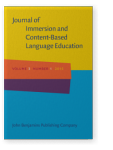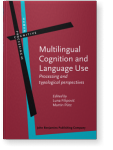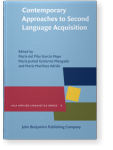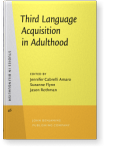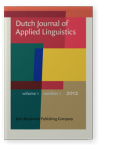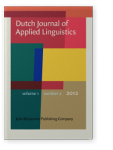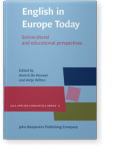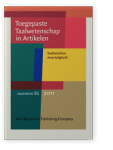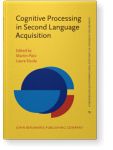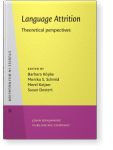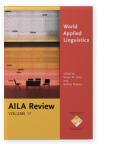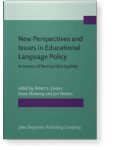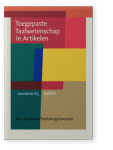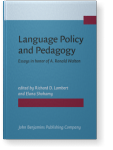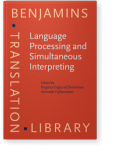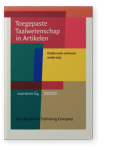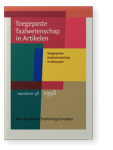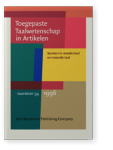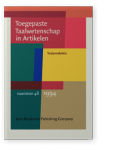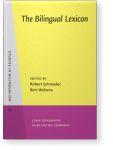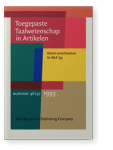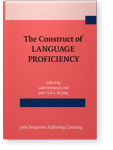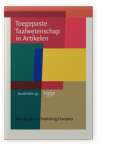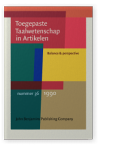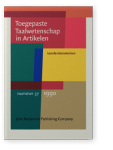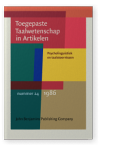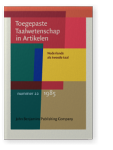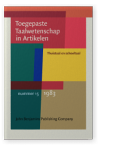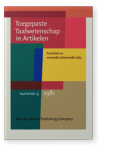Kees de Bot
List of John Benjamins publications for which Kees de Bot plays a role.
Journal
Book series
A Dynamic Approach to Second Language Development: Methods and techniques
Edited by Marjolijn H. Verspoor, Kees de Bot and Wander Lowie
[Language Learning & Language Teaching, 29] 2011. ix, 211 pp.
Subjects Applied linguistics | Language acquisition | Language teaching
Gestures in Language Development
Edited by Marianne Gullberg and Kees de Bot
[Benjamins Current Topics, 28] 2010. viii, 139 pp.
Subjects Gesture Studies | Language acquisition
Multidisciplinary Approaches to Code Switching
Edited by Ludmila Isurin, Donald Winford and Kees de Bot
[Studies in Bilingualism, 41] 2009. xviii, 364 pp.
Subjects Multilingualism | Psycholinguistics | Sociolinguistics and Dialectology | Theoretical linguistics
Gestures in language development
Edited by Marianne Gullberg and Kees de Bot
Special issue of Gesture 8:2 (2008) 145 pp.
Subjects Cognitive psychology | Communication Studies | Gesture Studies | Signed languages
Perspectives on Foreign Language Policy: Studies in honor of Theo van Els
Edited by Theo Bongaerts and Kees de Bot
[Not in series, 81] 1997. viii, 224 pp.
Subjects Applied linguistics | Language teaching
Foreign Language Research in Cross-Cultural Perspective
Edited by Kees de Bot, Ralph B. Ginsberg and Claire Kramsch
[Studies in Bilingualism, 2] 1991. xi, 275 pp.
Subjects Language acquisition | Language teaching | Sociolinguistics and Dialectology
Dimensions of Language Attrition
Edited by Kees de Bot, Michael Clyne and T.J.M. van Els
Special issue of ITL - International Journal of Applied Linguistics 83/84 (1989) ca. 162 pp.
Subjects Applied linguistics | Language acquisition | Language policy | Language teaching | Multilingualism
2018 Do low L2 abilities impede healthy aging for migrant older adults in the Netherlands? Dutch Journal of Applied Linguistics 7:1, pp. 109–120 | Article
Research towards aging of migrant populations has so far mostly focused on (bio)medical and psychological aspects. Here we explore to what extent second language ability is a factor influencing the healthy aging process of older Turkish migrants in the Netherlands. To get a first understanding… read more
2017 Chapter 2. Complexity Theory and Dynamic Systems Theory: Same or different? Complexity Theory and Language Development: In celebration of Diane Larsen-Freeman, Ortega, Lourdes and ZhaoHong Han (eds.), pp. 51–58 | Chapter
In this contribution, the history and use of the two labels Complexity Theory (CT) and Dynamic Systems Theory (DST) are presented. Although they have a different ontology, there does not seem to be a reason for choosing one or the other to refer to the same phenomenon. I propose to use the label… read more
2015 Factors associated with foreign language anxiety: A study of Chinese university learners of Japanese and English Dutch Journal of Applied Linguistics 4:1, pp. 67–85 | Article
This paper reports a study that investigates and compares the effects of foreign language proficiency, social status of a learner’s family, self-esteem, and competitiveness on FL anxiety. Chinese university students (N = 146), who were learning Japanese and English, participated in this study.… read more
2015 The effects of English bilingual education in the Netherlands Journal of Immersion and Content-Based Language Education 3:1, pp. 4–27 | Article
This paper reports on the effectiveness of bilingual education in the Netherlands. After a brief history of the rise of bilingual education in the Netherlands, the study traces the development of English proficiency of two cohorts at Dutch high schools during one year: a group of Year 1 students… read more
2014 Aging and bilingual processing: Age-related and individual differences in groups of early bilingual Frisians Multilingual Cognition and Language Use: Processing and typological perspectives, Filipović, Luna and Martin Pütz (eds.), pp. 263–286 | Article
We conducted a study to investigate effects of bilingualism on nonverbal and verbal cognitive performance. Here we report on the results from the first part of our study, in which 26 middle-aged (MA 46) and 26 elderly (MA 73.2) early bilingual speakers of Dutch and Frisian performed a verbal… read more
2013 Chapter 10. Dynamic Systems Theory as a comprehensive theory of second language development Contemporary Approaches to Second Language Acquisition, García Mayo, María del Pilar, María Juncal Gutiérrez Mangado and María Martínez-Adrián (eds.), pp. 199–220 | Chapter
In this contribution it is argued that Dynamic Systems Theory (DST) can be seen as a comprehensive theory that can unify and make relevant a number of different ‘middle level’ theories on Second Language Acquisition (SLA) which in our view are theories that attend to different levels of granularity… read more
2012 Rethinking multilingual processing: From a static to a dynamic approach Third Language Acquisition in Adulthood, Cabrelli, Jennifer, Suzanne Flynn and Jason Rothman (eds.), pp. 79–94 | Article
This contribution has four parts: in the first part, existing models of multilingual processing are presented and some of their main characteristics are discussed. In the second part, the Dynamic Systems Theory is presented in brief followed by a discussion what this means for our traditional way… read more
2012 Time scales in second language development Dutch Journal of Applied Linguistics 1:1, pp. 143–149 | Article
Development, and thus language development takes place at many interacting timescales, ranging from the milliseconds of lexical retrieval to pragmatic development at the scale of the life span. Different factors play a role in development at different time scales and even the same factor may play… read more
2012 A dynamic perspective on language processing and development Dutch Journal of Applied Linguistics 1:2, pp. 188–218 | Article
If language processing and development is viewed as a dynamic process in which all subsystems interact over time, then some basic assumptions behind more traditional approaches to language analysis are problematic: new methods of analysis and modeling are needed to supplement and partly replace… read more
2011 Epilogue A Dynamic Approach to Second Language Development: Methods and techniques, Verspoor, Marjolijn H., Kees de Bot and Wander Lowie (eds.), pp. 123–128 | Afterword
2011 Researching Second Language Development from a Dynamic Systems Theory perspective A Dynamic Approach to Second Language Development: Methods and techniques, Verspoor, Marjolijn H., Kees de Bot and Wander Lowie (eds.), pp. 5–24 | Article
2011 Introduction A Dynamic Approach to Second Language Development: Methods and techniques, Verspoor, Marjolijn H., Kees de Bot and Wander Lowie (eds.), pp. 1–4 | Introduction
2011 English as a foreign language: The role of out-of-school language input English in Europe Today: Sociocultural and educational perspectives, De Houwer, Annick and Antje Wilton (eds.), pp. 147–166 | Article
This chapter investigates to what extent the process of second language acquisition is influenced by amount and type of input. After a brief description of the place of English in the lives of secondary school students in the Netherlands, the article reports on a semi-longitudinal study comparing… read more
2011 The Role of Input and Scholastic Aptitude in Second Language Development Taalbeleid en meertaligheid, pp. 47–60 | Article
This semi-longitudinal/cross-sectional study explores the role of two possible variables in the L2 development of Dutch high school students: scholastic aptitude (operationalized as CITO score) and the amount of input, both in school (two hours a week versus 15 hours a week) and out of school.… read more
2010 7. On the stability of representations in the multilingual lexicon Cognitive Processing in Second Language Acquisition: Inside the learner's mind, Pütz, Martin and Laura Sicola (eds.), pp. 117–134 | Article
2010 Preface Gestures in Language Development, Gullberg, Marianne and Kees de Bot (eds.), p. | Preface
2010 Gestures and some key issues in the study of language development Gestures in Language Development, Gullberg, Marianne and Kees de Bot (eds.), pp. 3–33 | Article
2009 4. Sources of triggering in code switching Multidisciplinary Approaches to Code Switching, Isurin, Ludmila, Donald Winford and Kees de Bot (eds.), pp. 85–102 | Article
2009 5. Triggered code switching: Evidence from Dutch – English and Russian – English bilinguals Multidisciplinary Approaches to Code Switching, Isurin, Ludmila, Donald Winford and Kees de Bot (eds.), pp. 103–128 | Article
2008 Gestures and some key issues in the study of language development Gestures in language development, Gullberg, Marianne and Kees de Bot (eds.), pp. 149–179 | Article
The purpose of the current paper is to outline how gestures can contribute to the study of some key issues in language development. Specifically, we (1) briefly summarise what is already known about gesture in the domains of first and second language development, and development or changes over… read more
2007 Dynamic systems theory, lifespan development and language attrition Language Attrition: Theoretical perspectives, Köpke, Barbara, Monika S. Schmid, Merel Keijzer and Susan Dostert (eds.), pp. 53–68 | Article
The two basic questions in the field of language attrition are: why do people lose their language? and how do they lose their language? The former question concerns the factors which cause attrition, the latter the mechanics of the attrition process. Though the two questions are intimately related… read more
2004 Applied linguistics in Europe World Applied Linguistics: A Celebration of AILA at 40, Gass, Susan M. and Sinfree Makoni (eds.), pp. 57–68 | Article
In this contribution developments in Applied Linguistics in Europe are linked to major social changes that have taken place over the last decades. These include: The decline of the USSR and the end of the cold war; The development of the EEC and the EU and fading of borders; The economic growth of… read more
2001 Linking levels in foreign language teaching through a common frame of reference New Perspectives and Issues in Educational Language Policy: In honour of Bernard Dov Spolsky, Cooper, Robert L., Elana Shohamy and Joel Walters (eds.), pp. 197–208 | Article
2001 De Triggertheorie Voor Codewisseling: De oorspronkelijke en een aangepaste versie Toegepaste Taalwetenschap in Artikelen 65, pp. 41–54 | Article
This article is about the triggering hypothesis for codeswitching. The original version of the hypothesis is not compatible with recent theories on speech production. Its claim that words have a raised chance of being codeswitched when they verge on a trigger word is inconsistent with the… read more
2000 An Early Start for Foreign Languages (but Not English) in the Netherlands Language Policy and Pedagogy: Essays in honor of A. Ronald Walton, Lambert, Richard D. and Elana Shohamy (eds.), pp. 129–138 | Article
2000 Simultaneous Interpreting as Language Production Language Processing and Simultaneous Interpreting: Interdisciplinary perspectives, Englund Dimitrova, Birgitta and Kenneth Hyltenstam (eds.), pp. 65–88 | Article
2000 Effecten en Didactiek van Tweetalig Voortgezet Onderwijs Onderzoek ontmoet onderwijs, pp. 9–20 | Article
This paper presents the results of a recently completed longitudinal evaluation study of Dutch-English bilingual programmes in Dutch pre-university education. During several years the outcomes of these programmes were measured in order to find out whether pupils in bilingual education gain higher… read more
1998 Een Evaluatie Van Tweetalig Voortgezet Onderwijs in Nederland Toegepaste taalwetenschap in discussie, pp. 219–227 | Article
Since 1991, an increasing number of Dutch secondary schools have been offering a bilingual programme (Dutch-English) in the first four years of pre-university education. In 1995 a longitudinal evaluation study of this type of education was started. In this paper the first results of a part of this… read more
1997 Multilingualism in the Netherlands? Perspectives on Foreign Language Policy: Studies in honor of Theo van Els, Bongaerts, Theo and Kees de Bot (eds.), pp. 143–156 | Article
1996 Leren Praten en Door Praten Leren in Een Vreemde Taal Spreken in moedertaal en vreemde taal, pp. 9–23 | Article
In this article a description is given of the language production process based on Levelťs 'Speaking'-model. Using this type of model will help us to understand better the subprocesses in language production and the kind of knowledge and procedures needed to produce language. A full definition of… read more
1994 Woordproduktie bij Tweetaligen Taalproduktie, pp. 9–18 | Article
An attempt is made to validate an adaptation of Levelťs (1989) Speaking model to bilingual speakers. It is concluded that the best empirical evidence available at the moment comes from research on speech errors and code switching. Data from the latter source suggests that in word retrieval,… read more
1993 Word Production and the Bilingual Lexicon The Bilingual Lexicon, Schreuder, Robert and Bert Weltens (eds.), pp. 191–214 | Article
1992 Metalinguistic awareness in Dutch immigrants Australian Review of Applied Linguistics 15:2, pp. 19–28 | Article
In this paper data are presented on some aspects of metalinguistic awareness in Dutch adults who emigrated to Australia at least 25 years ago. A grammatically judgement test was administered to 37 informants in Melbourne. The data show that the migrants do not differ significantly from a control… read more
1992 11. Self-assessment of minority language proficiency The Construct of Language Proficiency: Applications of psychological models to language assessment, Verhoeven, Ludo and John H.A.L. de Jong (eds.), pp. 137–146 | Article
1991 Introduction to the Section on Teaching Environments Foreign Language Research in Cross-Cultural Perspective, Bot, Kees de, Ralph B. Ginsberg and Claire Kramsch (eds.), pp. 115–118 | Article
1991 Convergence and Divergence of Dialects: Language Change or Cognitive Dialectology? Toegepaste Taalwetenschap in Artikelen 41, pp. 15–26 | Article
In this paper two approaches to the concepts of convergence and divergence are described. The first concerns dialects as linguistic systems that may converge or diverge from each other or from the standard language, the second level concerns convergence and divergence as linguistic behaviour of in… read more
1991 Preface Foreign Language Research in Cross-Cultural Perspective, Bot, Kees de, Ralph B. Ginsberg and Claire Kramsch (eds.), p. | Preface
1991 Empirical Foreign Language Reaserch in Europe Foreign Language Research in Cross-Cultural Perspective, Bot, Kees de, Ralph B. Ginsberg and Claire Kramsch (eds.), pp. 21–34 | Article
1990 Preface Balance & perspective: 25 years of Dutch Applied Linguistics, pp. 3–4 | Article
1990 Leerlingkenmerken en Taalvaardigheid in Het Turks en Het Nederlands Leerderskenmerken: Individuele verschillen in het leren van talen., pp. 83–91 | Article
Evaluation of the effect of mother tongue teaching to migrant children in the Netherlands. Data are presented on first- and second-language proficiency of the Turkish sample (n=368). The aim of the investigation was to find out to what extent learner characteristics influence proficiency scores. It… read more
1989 Perception of Own Language Proficiency by Elderly Adults Dimensions of Language Attrition, Bot, Kees de, Michael Clyne and T.J.M. van Els (eds.), pp. 51–61 | Article
1989 Dimensions of Language Attrition: Introduction Dimensions of Language Attrition, Bot, Kees de, Michael Clyne and T.J.M. van Els (eds.), pp. i–iii | Article
1986 Code-Switching En Bilinguale Afasie Psycholinguistiek en taalstoornissen, pp. 24–34 | Article
In the literature on bilingual aphasia a number of patients have been described that show (spontaneous) language switching. Unfortunately, there is a lack of relevant information about the actual switching behaviour in the descript ion of these cases. In general, the occurrence of the phenomenon is… read more
1985 Het Meten van Culturele Oriëntatie in Relatie met Taalvaardigheid. Nederlands als tweede taal, pp. 33–49 | Article
Recently, numerous studies evaluating bilingual education programs have shown that cultural orientation and language attitude play an important role in achieving sufficient proficiency in both first and second language. Despite a long tradition . of research in the field of attitude measurement, no… read more
1983 Verslag van het Debat "Onderzoek - Praktijk" Thuistaal en schooltaal, p. | Article
1981 Intonation Teaching and Pitch Control ITL - International Journal of Applied Linguistics 52, pp. 31–42 | Article
1981 Visuele Terugkoppeling Van Engelse Intonatie; Fonetiek en vreemde-talenonderwijs, pp. 112–118 | Article
A description is given of an experiment in which we tried to show that visual feedback is more effective in intonation learning than auditory feedback. The factors in the experiment were feedback mode and practice time. The results showed a significant effect of visual feedback over auditory… read more
